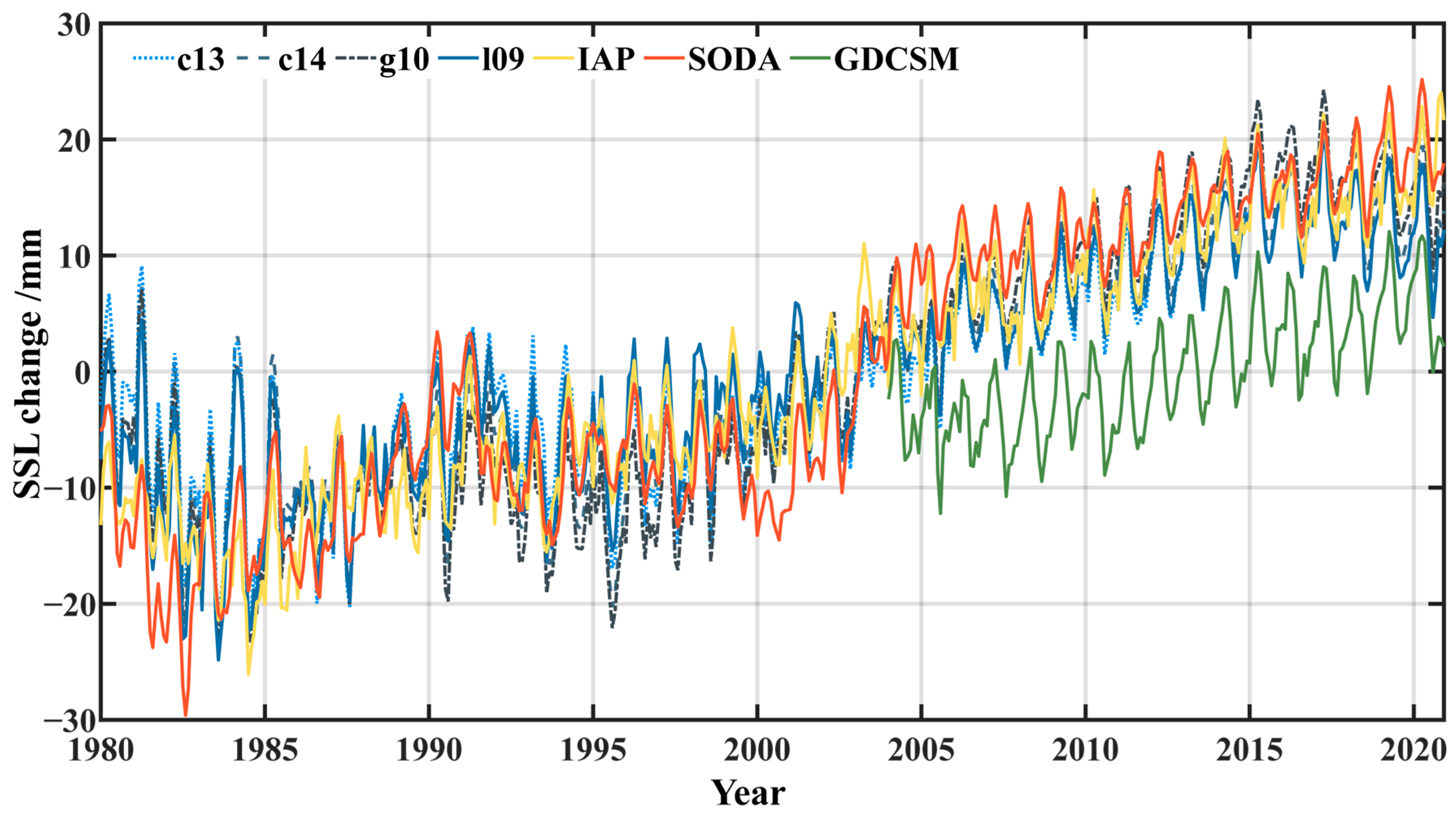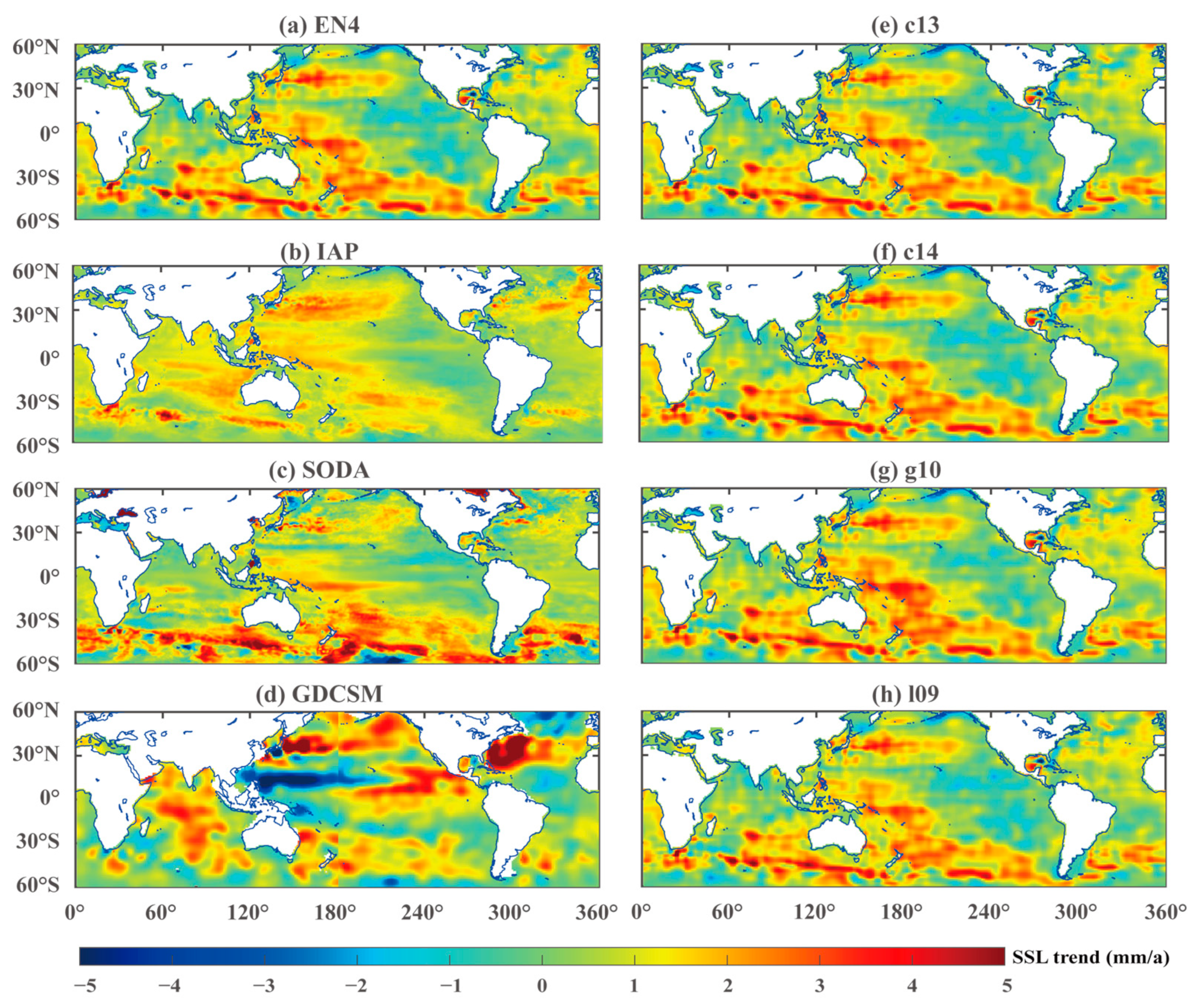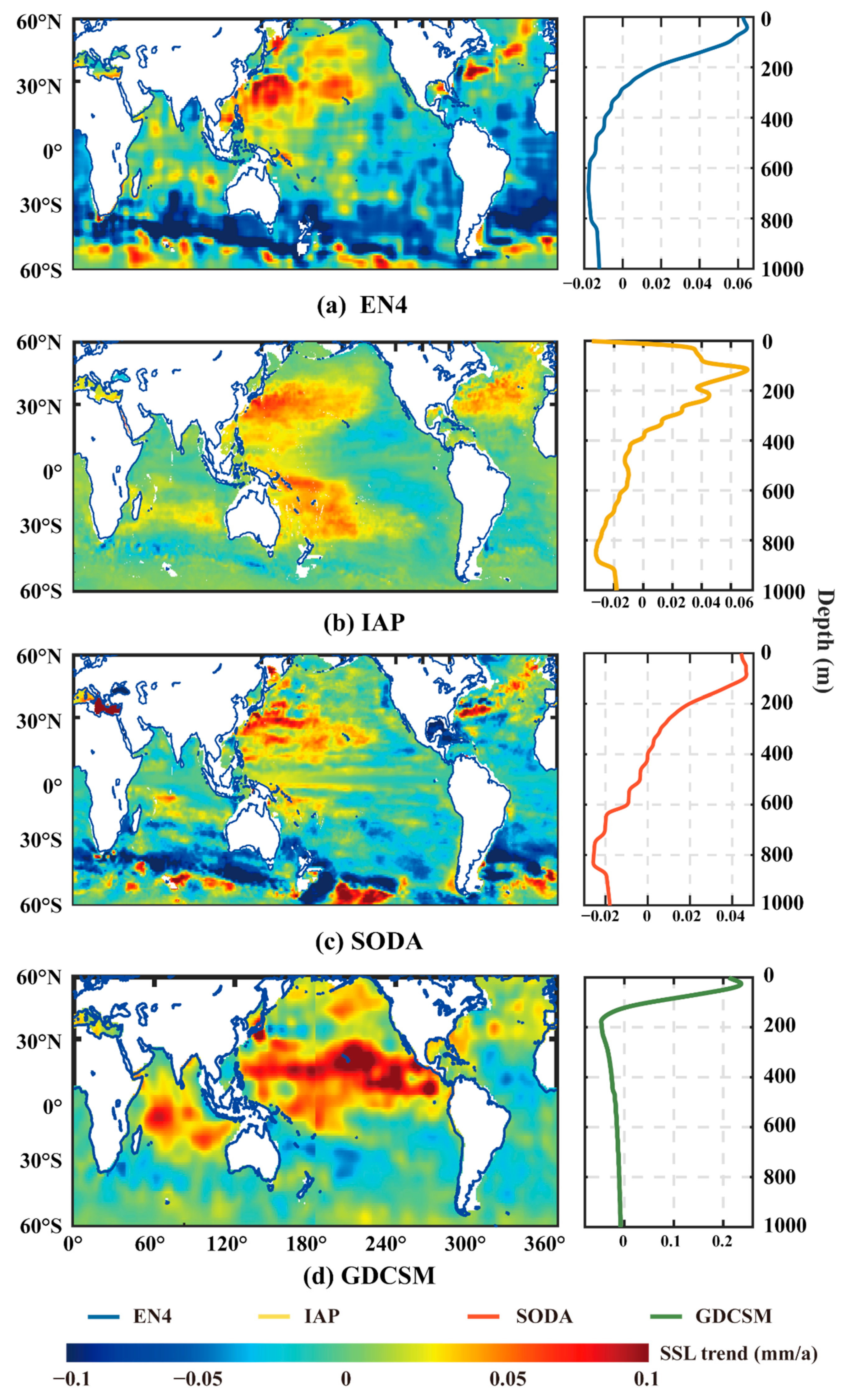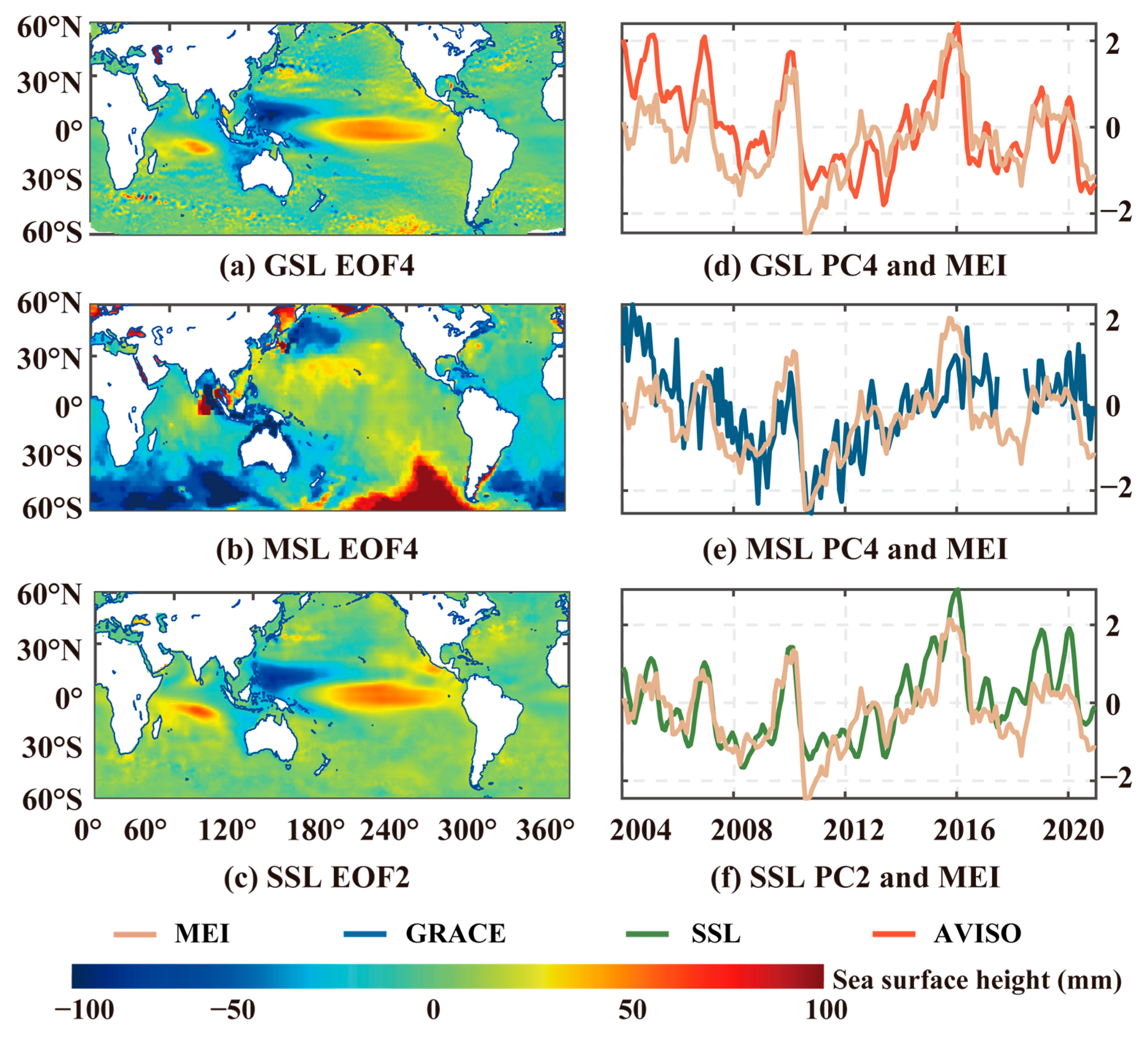Significant Increase in Global Steric Sea Level Variations over the Past 40 Years
Abstract
1. Introduction
2. Materials and Methods
2.1. Data
2.1.1. Temperature and Salinity Products
2.1.2. Satellite Altimetry Data
2.1.3. GRACE-Based Ocean Mass Data
2.1.4. ENSO-Associated Indices
2.2. Methods
2.2.1. SSL Calculation
2.2.2. Linear Regression for Time Series
2.2.3. Ensemble Empirical Mode Decomposition
2.2.4. Empirical Orthogonal Function
3. Results
3.1. SSL Changes Analysis
3.1.1. Temporal Characteristics
3.1.2. Spatial Distribution
3.1.3. Depth Variations
3.2. Relationship between Sea Level Variability and ENSO
3.2.1. Connection between SSL and ENSO in the Equatorial Pacific
3.2.2. Connection between Sea Level Change and ENSO on a Global Scale
4. Discussion
4.1. Comparison of SSL Changes Derived from Different Temperature and Salinity Products
4.2. GSL Variability and Its Response to Climate Change
4.3. Comparison with Previous Studies
5. Conclusions
Supplementary Materials
Author Contributions
Funding
Data Availability Statement
Acknowledgments
Conflicts of Interest
References
- Hua, L.; Xiao, C.; Yan, Z.; Yu, Y.; Zhang, T. Interpretation of IPCC AR6 report: Monitoring and Projections of Global and Regional Sea Level Change. Adv. Clim. Chang. Res. 2022, 18, 12–18. [Google Scholar] [CrossRef]
- IPCC. Climate Change 2021: The Physical Science Basis; Masson-Delmotte, V., Zhai, P., Pirani, A., Connors, S.L., Péan, C., Berger, S., Caud, N., Chen, Y., Goldfarb, L., Gomis, M.I., et al., Eds.; Cambridge University Press: Cambridge, UK, 2021. [Google Scholar] [CrossRef]
- Chen, M.; Chang, M.; Zhang, W.; Jia, Y.; Zuo, C. Characteristics of Low-frequency Variation of Global Steric Sea Level. Adv. Mar. Sci. 2016, 34, 162–174. [Google Scholar] [CrossRef]
- Royston, S.; Vishwakarma, B.D.; Westaway, R.; Rougier, J.; Sha, Z.; Bamber, J. Can We Resolve the Basin-Scale Sea Level Trend Budget From GRACE Ocean Mass? J. Geophys. Res.-Ocean. 2020, 125, 16. [Google Scholar] [CrossRef]
- Storto, A.; Masina, S.; Balmaseda, M.; Guinehut, S.; Xue, Y.; Szekely, T.; Fukumori, I.; Forget, G.; Chang, Y.S.; Good, S.A.; et al. Steric sea level variability (1993–2010) in an ensemble of ocean reanalyses and objective analyses. Clim. Dyn. 2017, 49, 709–729. [Google Scholar] [CrossRef]
- Yang, Y.Y.; Feng, W.; Zhong, M.; Mu, D.P.; Yao, Y.L. Basin-Scale Sea Level Budget from Satellite Altimetry, Satellite Gravimetry, and Argo Data over 2005 to 2019. Remote Sens. 2022, 14, 4637. [Google Scholar] [CrossRef]
- Zhang, M.; Zhao, C.; Zhang, Y.; Jiang, W.; Wang, G. Discrepancies in the Ocean Heat Content of Two EN4 Products. Adv. Mar. Sci. 2020, 38, 390–399. [Google Scholar]
- Good, S.A.; Martin, M.J.; Rayner, N.A. EN4: Quality controlled ocean temperature and salinity profiles and monthly objective analyses with uncertainty estimates. J. Geophys. Res. Ocean. 2013, 118, 6704–6716. [Google Scholar] [CrossRef]
- Zhang, C.L.; Wang, D.Y.; Liu, Z.H.; Lu, S.L.; Sun, C.H.; Wei, Y.L.; Zhang, M.X. Global Gridded Argo Dataset Based on Gradient-Dependent Optimal Interpolation. J. Mar. Sci. Eng. 2022, 10, 650. [Google Scholar] [CrossRef]
- Carton, J.A.; Chepurin, G.A.; Chen, L.G. SODA3: A New Ocean Climate Reanalysis. J. Clim. 2018, 31, 6967–6983. [Google Scholar] [CrossRef]
- Cheng, L.J.; Trenberth, K.E.; Fasullo, J.; Boyer, T.; Abraham, J.; Zhu, J. Improved estimates of ocean heat content from 1960 to 2015. Sci. Adv. 2017, 3, e1601545. [Google Scholar] [CrossRef]
- Cowley, R.; Wijffels, S.; Cheng, L.; Boyer, T.; Kizu, S. Biases in Expendable Bathythermograph Data: A New View Based on Historical Side-by-Side Comparisons. J. Atmos. Ocean. Technol. 2013, 30, 1195–1225. [Google Scholar] [CrossRef]
- Cheng, L.; Zhu, J.; Cowley, R.; Boyer, T.; Wijffels, S. Time, Probe Type, and Temperature Variable Bias Corrections to Historical Expendable Bathythermograph Observations. J. Atmos. Ocean. Technol. 2014, 31, 1793–1825. [Google Scholar] [CrossRef]
- Gouretski, V.; Reseghetti, F. On depth and temperature biases in bathythermograph data: Development of a new correction scheme based on analysis of a global ocean database. Deep Sea Res. Part I Oceanogr. Res. Pap. 2010, 57, 812–833. [Google Scholar] [CrossRef]
- Levitus, S.; Antonov, J.I.; Boyer, T.P.; Locarnini, R.A.; Garcia, H.E.; Mishonov, A.V. Global ocean heat content 1955-2008 in light of recently revealed instrumentation problems. Geophys. Res. Lett. 2009, 36, 5. [Google Scholar] [CrossRef]
- Wei, F.; Min, Z. Global sea level variations from altimetry, GRACE and Argo data over 2005–2014. Geod. Geodyn. 2015, 6, 274–279. [Google Scholar]
- Minster, J.; Cazenave, A.; Serafini, Y.; Mercier, F.; Gennero, M.; Rogel, P. Annual cycle in mean sea level from Topex–Poseidon and ERS-1: Inference on the global hydrological cycle. Glob. Planet Chang. 1999, 20, 57–66. [Google Scholar] [CrossRef]
- Save, H.; Bettadpur, S.; Tapley, B.D. High-resolution CSR GRACE RL05 mascons. J. Geophys. Res.-Solid Earth 2016, 121, 7547–7569. [Google Scholar] [CrossRef]
- Watkins, M.M.; Wiese, D.N.; Yuan, D.N.; Boening, C.; Landerer, F.W. Improved methods for observing Earth’s time variable mass distribution with GRACE using spherical cap mascons. J. Geophys. Res. Solid Earth 2015, 120, 2648–2671. [Google Scholar] [CrossRef]
- Chen, H.; Xu, F.; Li, X.; Xia, T.; Zhang, Y. Intensities and time-frequency variability of enso in the last 65 years. J. Trop. Meteorol. 2017, 33, 683–694. [Google Scholar] [CrossRef]
- Li, X.; Zhai, P. On indices and indicators of ENSO episodes. Acta Meteorol. Sin. 2000, 58, 102–109. [Google Scholar] [CrossRef]
- Zhao, Y.; Chen, Y. Classification and Cycles of ENSO Events Over the Past Century. Trans. Oceanol. Limnol. 1998, 12, 7–13. [Google Scholar]
- Xi, H.; Zhang, Z.Z.; Lu, Y.; Li, Y. Long-Term and Interannual Variation of the Steric Sea Level in the South China Sea and the Connection with ENSO. J. Coast. Res. 2019, 35, 489–498. [Google Scholar] [CrossRef]
- Zhong, Y.; Zhong, M.; Feng, W. Monitoring the cause of global mean sea level with satellite gravity and analyzing the correlation with ENSO in recent decade. Prog. Geophys. 2016, 31, 643–648. [Google Scholar]
- GB/T 33666-2017; El Niño/La Niña Event Identification Methods. Standardization Administration of the People’s Republic of China: Beijing, China, 2017; p. 2.
- Ropelewski, C.F.; Jones, P.D. An extension of the Tahiti-Darwin Southern Oscillation Index. Mon. Weather Rev. 1987, 115, 2161–2165. [Google Scholar] [CrossRef]
- Trenberth, K.E.; Stepaniak, D.P. Indices of El Nino evolution. J. Clim. 2001, 14, 1697–1701. [Google Scholar] [CrossRef]
- Zhang, T.; Hoell, A.; Perlwitz, J.; Eischeid, J.; Murray, D.; Hoerling, M.; Hamill, T.M. Towards Probabilistic Multivariate ENSO Monitoring. Geophys. Res. Lett. 2019, 46, 10532–10540. [Google Scholar] [CrossRef]
- Chen, J.L.; Wilson, C.R.; Tapley, B.D.; Famiglietti, J.S.; Rodell, M. Seasonal global mean sea level change from satellite altimeter, GRACE, and geophysical models. J. Geod. 2005, 79, 532–539. [Google Scholar] [CrossRef]
- Fofonoff, N.P.; Millard, R.C. Algorithms for Computation of Fundamental Properties of Seawater; UNESCO Technical Papers in Marine Sciences; UNESCO: Paris, France, 1983; 53p. [Google Scholar] [CrossRef]
- Wang, F.W.; Shen, Y.Z.; Chen, Q.J.; Sun, Y. Reduced misclosure of global sea-level budget with updated Tongji-Grace2018 solution. Sci. Rep. 2021, 11, 17667. [Google Scholar] [CrossRef]
- Dhomps, A.L.; Guinehut, S.; Le Traon, P.Y.; Larnicol, G. A global comparison of Argo and satellite altimetry observations. Ocean Sci. 2011, 7, 175–183. [Google Scholar] [CrossRef]
- Torres, R.R.; Tsimplis, M.N. Seasonal sea level cycle in the Caribbean Sea. J. Geophys. Res.-Ocean. 2012, 117, 18. [Google Scholar] [CrossRef]
- Ezer, T.; Corlett, W.B. Analysis of relative sea level variations and trends in the Chesapeake Bay: Is there evidence for acceleration in sea level rise? In Proceedings of the 2012 Oceans, Hampton Roads, VA, USA, 14–19 October 2012; pp. 1–5. [Google Scholar] [CrossRef]
- Wu, Z.; Huang, N.E. Ensemble empirical mode decomposition: A noise-assisted data analysis method. Adv. Adapt Data Anal. 2011, 1, 1–41. [Google Scholar] [CrossRef]
- Wu, S.; Liu, Z.Y.; Zhang, R.; Delworth, T.L. On the observed relationship between the Pacific Decadal Oscillation and the Atlantic Multi-decadal Oscillation. J. Oceanogr. 2011, 67, 27–35. [Google Scholar] [CrossRef]
- Preisendorfer, R.W. Principal Component Analysis in Meteorology and Oceanography; Elsevier: Amsterdam, The Netherlands, 1988; pp. 212–214. [Google Scholar]
- North, G.R.; Bell, T.L.; Cahalan, R.F.; Moeng, F.J. Sampling errors in the estimation of empirical orthogonal functions. Mon. Weather Rev. 1982, 110, 699–706. [Google Scholar] [CrossRef]
- Nerem, R.S.; Rachlin, K.E.; Beckley, B.D. Characterization of global mean sea level variations observed by TOPEX/POSEIDON using empirical orthogonal functions. Surv. Geophys. 1997, 18, 293–302. [Google Scholar] [CrossRef]
- Torrence, C.; Webster, P.J. Interdecadal changes in the ENSO-monsoon system. J. Clim. 1999, 12, 2679–2690. [Google Scholar] [CrossRef]
- Boyer, T.; Domingues, C.M.; Good, S.A.; Johnson, G.C.; Lyman, J.M.; Ishii, M.; Gouretski, V.; Antonov, J.; Wijffels, S.; Church, J.A.; et al. Sensitivity of Global Upper-Ocean Heat Content Estimates to Mapping Methods, XBT Bias Corrections, and Baseline Climatologies. J. Clim. 2016, 29, 4817–4842. [Google Scholar] [CrossRef]
- Abraham, J.P.; Baringer, M.; Bindoff, N.L.; Boyer, T.; Cheng, L.; Church, J.A.; Conroy, J.L.; Domingues, C.M.; Fasullo, J.T.; Gilson, J. A review of global ocean temperature observations: Implications for ocean heat content estimates and climate change. Rev. Geophys. 2013, 51, 450–483. [Google Scholar] [CrossRef]
- Cheng, L.; Zhu, J.; Abraham, J. Global Upper Ocean Heat Content Estimation: Recent Progress and the Remaining Challenges. Atmos. Ocean. Sci. Lett. 2015, 8, 333–338. [Google Scholar] [CrossRef]
- Ishii, M.; Kimoto, M. Reevaluation of historical ocean heat content variations with time-varying XBT and MBT depth bias corrections. J. Oceanogr. 2009, 65, 287–299. [Google Scholar] [CrossRef]
- Piecuch, C.G.; Quinn, K.J. El Nino, La Nina, and the global sea level budget. Ocean Sci. 2016, 12, 1165–1177. [Google Scholar] [CrossRef]
- Boening, C.; Willis, J.K.; Landerer, F.W.; Nerem, R.S.; Fasullo, J. The 2011 La Nina: So strong, the oceans fell. Geophys. Res. Lett. 2012, 39, 5. [Google Scholar] [CrossRef]
- von Schuckmann, K.; Palmer, M.D.; Trenberth, K.E.; Cazenave, A.; Chambers, D.; Champollion, N.; Hansen, J.; Josey, S.A.; Loeb, N.; Mathieu, P.P.; et al. An imperative to monitor Earth’s energy imbalance. Nat. Clim. Chang. 2016, 6, 138–144. [Google Scholar] [CrossRef]
- Hawkings, J.R.; Wadham, J.L.; Tranter, M.; Lawson, E.; Sole, A.; Cowton, T.; Tedstone, A.J.; Bartholomew, I.; Nienow, P.; Chandler, D.; et al. The effect of warming climate on nutrient and solute export from the Greenland Ice Sheet. Geochem. Perspect. Lett. 2015, 1, 94–104. [Google Scholar] [CrossRef]
- Etourneau, J.; Sgubin, G.; Crosta, X.; Swingedouw, D.; Willmott, V.; Barbara, L.; Houssais, M.N.; Schouten, S.; Damsté, J.S.S.; Goosse, H. Ocean temperature impact on ice shelf extent in the eastern Antarctic Peninsula. Nat. Commun. 2019, 10, 304. [Google Scholar] [CrossRef]
- McManus, J.F.; Francois, R.; Gherardi, J.M.; Keigwin, L.D.; Brown-Leger, S. Collapse and rapid resumption of Atlantic meridional circulation linked to deglacial climate changes. Nature 2004, 428, 834–837. [Google Scholar] [CrossRef] [PubMed]
- Cazenave, A.; Dieng, H.B.; Meyssignac, B.; von Schuckmann, K.; Decharme, B.; Berthier, E. The rate of sea-level rise. Nat. Clim. Chang. 2014, 4, 358–361. [Google Scholar] [CrossRef]
- Mu, D.P.; Xu, T.H.; Guan, M.Q. Sea level instantaneous budget for 2003–2015. Geophys. J. Int. 2022, 229, 828–837. [Google Scholar] [CrossRef]
- Chen, J.L.; Tapley, B.; Wilson, C.; Cazenave, A.; Seo, K.W.; Kim, J.S. Global Ocean Mass Change From GRACE and GRACE Follow-On and Altimeter and Argo Measurements. Geophys. Res. Lett. 2020, 47, e2020GL090656. [Google Scholar] [CrossRef]
- Amin, H.; Bagherbandi, M.; Sjöberg, L.E. Quantifying barystatic sea-level change from satellite altimetry, GRACE and Argo observations over 2005–2016. Adv. Space Res. 2020, 65, 1922–1940. [Google Scholar] [CrossRef]
- Li, Z.A.; Chen, J.; Li, J.; Hu, X. Temporal and Spatial Variations of Global Steric Sea Level Change from Argo Observations, 2005–2015. J. Geod. Geodyn. 2018, 38, 923–929. [Google Scholar] [CrossRef]
- Barnoud, A.; Pfeffer, J.; Guérou, A.; Frery, M.L.; Siméon, M.; Cazenave, A.; Chen, J.; Llovel, W.; Thierry, V.; Legeais, J.F. Contributions of Altimetry and Argo to Non-Closure of the Global Mean Sea Level Budget Since 2016. Geophys. Res. Lett. 2021, 48, e2021GL092824. [Google Scholar] [CrossRef]









| Datasets | Period | Spatial Coverage | Horizontal Resolution | Vertical Resolution | Raw Data | Background Field | Assimilation Method |
|---|---|---|---|---|---|---|---|
| EN4 | 1900−Present | 180°W–180°E, 83°S–89°N | 1° × 1° | 42 Layers from 5 to 5350 m | WOD18, Argo, GTSPP, ASBO | WOA98 | Optimal interpolation |
| GDCSM | 2004–2022 | 179.5°W–179.5°E, 89.5°S–89.5°N | 1° × 1° | 58 Layers from 0 to 2000 m | Argo | Multi-year monthly mean analysis field | Gradient-dependent correlation scale method |
| SODA | 1980–2020 | 180°W–180°E, 75°S–90°N | 0.5° × 0.5° | 50 Layers from 0 to 5500 m | WOD13, SST | CM2.5 coupled model | Computationally efficient optimal interpolation |
| IAP | 1960–Present | 180°W–180°E, 90°S–90°N | 1° × 1° | 24 Layers from 0 to 2000 m | WOD18 | Climate model ensemble mean field | Ensemble optimal interpolation |
| Dataset | Annual | Linear Trend (mm/a) | ||
|---|---|---|---|---|
| Amplitude (mm) | Phase (deg) | |||
| EN4 | c13 | 4.06 ± 0.56 | 356.08 ± 7.85 | 0.64 ± 0.03 |
| c14 | 3.98 ± 0.56 | 356.17 ± 8.08 | 0.75 ± 0.03 | |
| g10 | 4.09 ± 0.65 | 356.90 ± 9.16 | 0.87 ± 0.04 | |
| l09 | 4.01 ± 0.45 | 354.94 ± 6.43 | 0.71 ± 0.03 | |
| IAP | 2.99 ± 0.38 | 342.71 ± 7.28 | 0.89 ± 0.02 | |
| SODA | 3.24 ± 0.58 | 345.92 ± 10.18 | 0.97 ± 0.03 | |
| GDCSM | 4.11 ± 0.35 | 347.15 ± 4.85 | 0.74 ± 0.05 | |
| EOF Modes | EN4-Derived SSL Trend | IAP-Derived SSL Trend | SODA-Derived SSL Trend | GDCSM-Derived SSL Trend |
|---|---|---|---|---|
| Percentage of Variance (%) | Percentage of Variance (%) | Percentage of Variance (%) | Percentage of Variance (%) | |
| PC1 | 62.1 | 37.8 | 89.0 | 49.8 |
| PC2 | 15.3 | 30.1 | 5.3 | 30.4 |
| PC3 | 8.0 | 8.8 | 2.8 | 7.0 |
| PC4 | 5.4 | 7.2 | 1.5 | 4.9 |
| PC5 | 2.5 | 6.2 | 0.9 | 3.6 |
| EOF Modes | EN4-Derived SSL | IAP-Derived SSL | SODA-Derived SSL | GDCSM-Derived SSL | ||||
|---|---|---|---|---|---|---|---|---|
| Percentage of Variance (%) | CC | Percentage of Variance (%) | CC | Percentage of Variance (%) | CC | Percentage of Variance (%) | CC | |
| PC1 | 24.5 | 0.86 | 24.0 | 0.78 | 21.4 | 0.85 | 27.1 | 0.80 |
| PC2 | 13.2 | −0.12 | 16.6 | 0.40 | 11.6 | 0.07 | 15.8 | 0.32 |
| PC3 | 10.8 | 0.20 | 14.2 | 0.06 | 11.1 | 0.28 | 12.2 | −0.11 |
| PC4 | 5.1 | 0.06 | 6.5 | −0.15 | 4.8 | 0.07 | 5.8 | −0.04 |
| PC5 | 4.8 | −0.10 | 4.3 | −0.05 | 4.2 | −0.02 | 3.6 | 0.05 |
| EOF Modes | GSL | SSL | MSL | |||
|---|---|---|---|---|---|---|
| Percentage of Variance (%) | CC | Percentage of Variance (%) | CC | Percentage of Variance (%) | CC | |
| PC1 | 12.9 | −0.30 | 29.3 | 0.07 | 46.1 | 0.17 |
| PC2 | 9.3 | 0.19 | 13.6 | 0.77 | 16.5 | −0.02 |
| PC3 | 5.5 | 0.36 | 8.2 | 0.31 | 6.5 | 0.03 |
| PC4 | 5.2 | 0.70 | 5.7 | −0.22 | 3.5 | 0.58 |
| PC5 | 2.4 | 0.19 | 3.8 | 0.20 | 2.2 | 0.30 |
| Source | Time Span | Data Sources | SSL Trend (mm/a) |
|---|---|---|---|
| This study | 2003–2020 | EN4 (c13, c14, g10, l09), IAP, SODA, GDCSM | 0.90 ± 0.06 |
| Mu et al. [52] | 2003–2015 | JAMSTEC, EN4, BOA-Argo | 1.13 ± 0.12 |
| Amin et al. [54] | 2005–2016 | IPRC, JAMSTEC, SIO, EN4, CSIO | 1.20 ± 0.07 |
| Wang et al. [31] | 2005–2016 | IPRC, SIO | 1.16 ± 0.08 |
| Chen et al. [53] | 2005–2020 | SIO, IPRC, JAMSTEC | 1.00 ± 0.22 |
| Yang et al. [6] | 2005–2019 | BOA-Argo, CORA, IAP, IPRC, JAMSTEC, NCEI, SIO, EN4 (g10, l09) | 1.05 ± 0.14 |
| Royston et al. [4] | 2005–2015 | SIO, EN4(g14), ISAS15, JAMSTEC | 0.96 ± 0.08 |
| Barnoud et al. [56] | 2005–2019 | NOAA, EN4, SCRIPPS, JAMSTEC | 1.07 ± 0.08 |
Disclaimer/Publisher’s Note: The statements, opinions and data contained in all publications are solely those of the individual author(s) and contributor(s) and not of MDPI and/or the editor(s). MDPI and/or the editor(s) disclaim responsibility for any injury to people or property resulting from any ideas, methods, instructions or products referred to in the content. |
© 2024 by the authors. Licensee MDPI, Basel, Switzerland. This article is an open access article distributed under the terms and conditions of the Creative Commons Attribution (CC BY) license (https://creativecommons.org/licenses/by/4.0/).
Share and Cite
Xie, J.; Sun, Z.; Zhou, S.; Zhong, Y.; Sun, P.; Xiong, Y.; Tu, L. Significant Increase in Global Steric Sea Level Variations over the Past 40 Years. Remote Sens. 2024, 16, 2466. https://doi.org/10.3390/rs16132466
Xie J, Sun Z, Zhou S, Zhong Y, Sun P, Xiong Y, Tu L. Significant Increase in Global Steric Sea Level Variations over the Past 40 Years. Remote Sensing. 2024; 16(13):2466. https://doi.org/10.3390/rs16132466
Chicago/Turabian StyleXie, Jinpeng, Zhangli Sun, Shuaibo Zhou, Yulong Zhong, Peijun Sun, Yi Xiong, and Lin Tu. 2024. "Significant Increase in Global Steric Sea Level Variations over the Past 40 Years" Remote Sensing 16, no. 13: 2466. https://doi.org/10.3390/rs16132466
APA StyleXie, J., Sun, Z., Zhou, S., Zhong, Y., Sun, P., Xiong, Y., & Tu, L. (2024). Significant Increase in Global Steric Sea Level Variations over the Past 40 Years. Remote Sensing, 16(13), 2466. https://doi.org/10.3390/rs16132466







